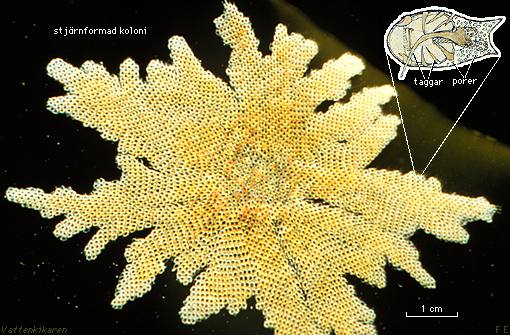|

Distribution in scandinavian waters
|
Maximum length: The colonies
can be as large as several centimetres. Individuals, who grow inside
a secreted case called a zooecium, can be as small as 0,5 mm.
Appearance: The thin, but hard chalky colonies of sea-mat are
easily recognized when they have grown so large that they build a star-formed
splat. They are usually silver-white in colour. The zooeciums are
rounded and around the edges of these openings are hairs. Sometimes
the anterior hairs can be as long as 1mm. On such occasions it seems
as though the colony consists of
a lot of bristles. Colonies that grow around cylindrical algae usually
have the longest bristles.
Compare the hairy sea-mat with the common
sea-mat and other closely
related sea-mats.
Depth: 0-70 m.
Environment: Hairy sea-mats are found on amongst other things
algae,
cliffs,
rocks, and shells.
Misc: Hairy sea-mats catch and eat
particles that are suspended in the water. There are very few creatures
that prey on the sea-mats, but certain sea-spiders, sea urchins and
nudibranchs
do.
The hairy sea-mat does not usually occur in areas with
low salinity
(brackish). In such areas they are usually replaced by the closely
related Electra crustulenta, which is quite common even in the
Gulf of Bothnia.
Classification: The hairy sea-mat is a member of the sea-mat
group.
|


